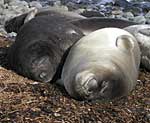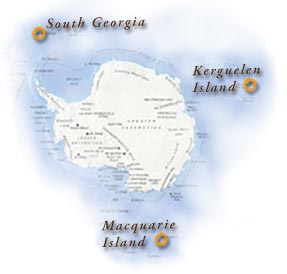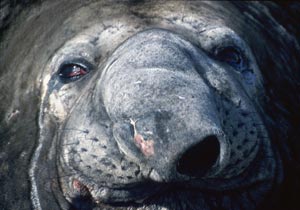 |
Natural History:
The Life of the Southern Elephant Seal
|
 |
Southern Elephant Seals breed in the Sub-Antarctic, and range widely over the Southern Ocean. Within this region there are eight or more important breeding colonies, the largest of which are at Macquarie, Kerguelen, and at South Georgia. The global population is approximately 740,000 seals, of which some 400,000 belong to the South Georgia colony.
 Seal pups are born on land, and remain with their mothers suckling for around three weeks. After this period they are left by their mothers, and the pups remain at the colony for a further four to eight more weeks before they go to sea. They must go sea, as, apart from when they suckle as pups, elephant seals only feed in the ocean. Seal pups are born on land, and remain with their mothers suckling for around three weeks. After this period they are left by their mothers, and the pups remain at the colony for a further four to eight more weeks before they go to sea. They must go sea, as, apart from when they suckle as pups, elephant seals only feed in the ocean.
The sea-going phases of the elephant seal’s life are periods about which we have, until recently, known comparatively little. And yet they spend the greater part of their lives in the ocean, and it is there that they display what are perhaps their most amazing capabilities and adaptations. Food sources, such as squid or large fish, are not found near the seal colonies, and individuals will typically make ocean journeys of up to 4000km on feeding trips.
|


|
| |
In the course of these extended cruises, elephant seals spend as much as 90% of the time underwater, their brief visits to the surface lasting only for the few minutes required to breathe. They may dive to 2000m or more, often remaining submerged for over an hour at a stretch. These are profound depths, and, although these regions can be visited by some other marine mammals such as sperm whales, these depths are far beyond the reach of the majority of military submarines, and can only be reached by humans in specially constructed research vehicles. Elephant seals can only sustain this kind of extreme physical activity because of a collection of remarkable adaptations, particularly relating to oxygen management and blood flow.
|
|
|
After two to three months feeding at sea, adult southern elephant seals return to land in late summer to moult for approximately one month. During this period old skin and hair are replaced. The moult is similar to the process by which skin is replaced in other animals, such as humans, but occurs “all at once” rather than continuously. This is a necessary adaptation for an Antarctic dwelling marine mammal, whose skin must remain in good condition while at sea. They must be on land to moult to avoid exposure to the severe cold of the Southern Ocean.
After moulting southern elephant seals return to sea for a further five to seven months before returning to one of the breeding colonies. After pregnant females have given birth and suckled their pups, they are again ready to mate. Altogether, giving birth, suckling, and mating occurs over a period of three to four weeks before the adults again return to sea.
During the breeding season, males maintain a ‘harem’, and may mate with hundreds of females.
|
| |
| Sexual Dimorphism |
 The way in which elephant seals grow is an evolutionary response to their breeding behaviour. The way in which elephant seals grow is an evolutionary response to their breeding behaviour.
Since the elephant seals only feed at sea, the bull must meet the considerable energy requirements of seeing off challengers, and mating with females himself, entirely from his own reserves of stored fat. These pressures mean that large males are much more likely to meet with breeding success. Over time, this has produced huge mature male elephant seals. Where females are 2 – 3m long, males are 4 – 5m, and may weigh up to 4 tonnes, as much as ten times more than an adult female.

Differences of this type between the forms of the sexes are said to be examples of “sexual dimorphism”. Another example in the case of the elephant seal is the “trunk” which is only present in adult males. |
|
 The bull’s breeding rights over this group are jealously guarded. To prevent other males from mating with any of the harem, the presiding bull must be able to meet any challenge over an extended period of time. Challenges take the form of aggressive, and often bloody disputes. The bull’s breeding rights over this group are jealously guarded. To prevent other males from mating with any of the harem, the presiding bull must be able to meet any challenge over an extended period of time. Challenges take the form of aggressive, and often bloody disputes.
Male and female seals develop very differently
[see ‘sexual dimorphism’].
Females may breed at three to four years of age, but males are likely to be at least ten years old before they can challenge any mature bull for breeding rights.
Southern elephant seals can live for about 30 years.
|
| |
 |
| |
|
|




 The bull’s breeding rights over this group are jealously guarded. To prevent other males from mating with any of the harem, the presiding bull must be able to meet any challenge over an extended period of time. Challenges take the form of aggressive, and often bloody disputes.
The bull’s breeding rights over this group are jealously guarded. To prevent other males from mating with any of the harem, the presiding bull must be able to meet any challenge over an extended period of time. Challenges take the form of aggressive, and often bloody disputes.

![]()
 Seal pups are born on land, and remain with their mothers suckling for around three weeks. After this period they are left by their mothers, and the pups remain at the colony for a further four to eight more weeks before they go to sea. They must go sea, as, apart from when they suckle as pups, elephant seals only feed in the ocean.
Seal pups are born on land, and remain with their mothers suckling for around three weeks. After this period they are left by their mothers, and the pups remain at the colony for a further four to eight more weeks before they go to sea. They must go sea, as, apart from when they suckle as pups, elephant seals only feed in the ocean.








 The way in which elephant seals grow is an evolutionary response to their breeding behaviour.
The way in which elephant seals grow is an evolutionary response to their breeding behaviour. 